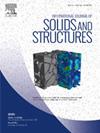Bond exchange reactions as a paradigm for mitigating residual stress in polymer matrix fiber composites
IF 3.4
3区 工程技术
Q1 MECHANICS
International Journal of Solids and Structures
Pub Date : 2025-02-19
DOI:10.1016/j.ijsolstr.2025.113286
引用次数: 0
Abstract
Polymer matrix fiber composites often suffer from residual stresses due to differences in coefficients of thermal expansion between the fibers and resins, as well as contractile strain of the resins during curing. To address residual stress driven composite failure, we propose the use of vitrimers as composite resins, which can undergo thermally activated, stress alleviating, bond exchange reactions (BERs). We conduct fiber Bragg grating measurements for a single glass fiber within bulk vitrimer. These show that the fiber strain in vitrimers with 5% catalyst is significantly lower than in those with 0% catalyst (minimal BER expected) during both curing and post-curing phases. We developed a finite deformation, micromechanically-inspired model that incorporates curing, thermal processes, and BERs, and then implemented this model it into finite element software to simulate stress evolution within single fiber composite systems. The combination of experimental and computational results reveals that BERs can effectively mitigate, but not eliminate, the residual stress in polymer matrix fiber composites.
求助全文
约1分钟内获得全文
求助全文
来源期刊
CiteScore
6.70
自引率
8.30%
发文量
405
审稿时长
70 days
期刊介绍:
The International Journal of Solids and Structures has as its objective the publication and dissemination of original research in Mechanics of Solids and Structures as a field of Applied Science and Engineering. It fosters thus the exchange of ideas among workers in different parts of the world and also among workers who emphasize different aspects of the foundations and applications of the field.
Standing as it does at the cross-roads of Materials Science, Life Sciences, Mathematics, Physics and Engineering Design, the Mechanics of Solids and Structures is experiencing considerable growth as a result of recent technological advances. The Journal, by providing an international medium of communication, is encouraging this growth and is encompassing all aspects of the field from the more classical problems of structural analysis to mechanics of solids continually interacting with other media and including fracture, flow, wave propagation, heat transfer, thermal effects in solids, optimum design methods, model analysis, structural topology and numerical techniques. Interest extends to both inorganic and organic solids and structures.

 求助内容:
求助内容: 应助结果提醒方式:
应助结果提醒方式:


